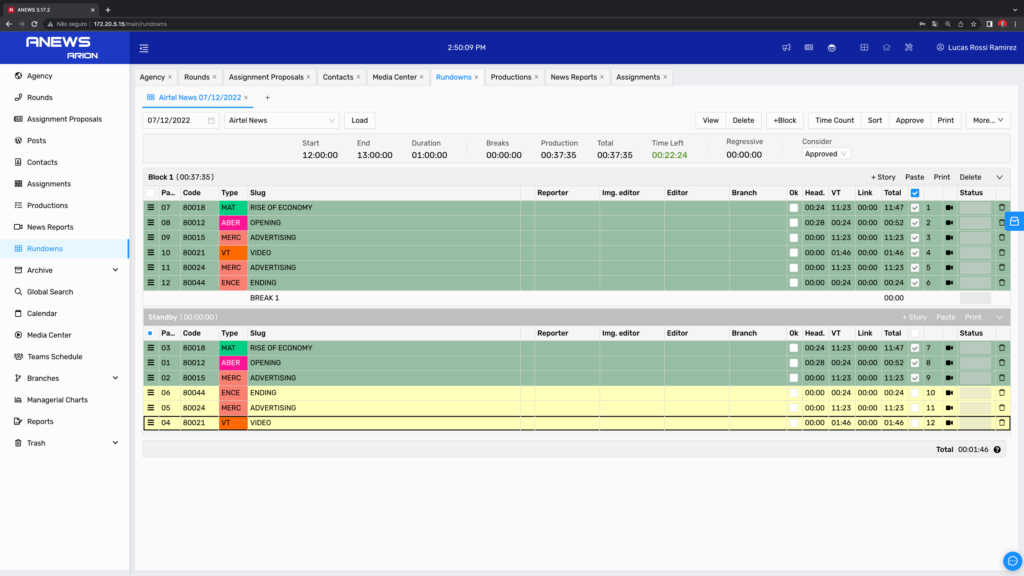
Journalists who organize news stories efficiently and quickly should know the importance of coming up with a strong rundown. In this context, the TV news rundown is an ally for the entire team to distribute the news in a way that engages the audience.
If you have to structure the stories to air, but you’re still not sure how to do it, don’t worry! We came up with this article exactly to detail everything about TV news rundowns and to help you with this very important tool.
Check out the content below now!
What is a TV news rundown?
A TV news rundown is the name given to the newscast’s schedule, which is prepared by the editor-in-chief to serve as a guide to all those involved during the broadcast. Its role is to detail how the news content will be presented.
As such, it shows the entry sequence of stories, live broadcasts, breaks, interviews and others. That is, everything that will be part of that edition of the newscast.
In short, the rundown organizes the sequence of entries and the duration of each one so that time does not run out — that is, goes beyond the time allocated to that edition of the newscast. Therefore, everyone involved must be aware of this time limit, from directors to reporters, including the camera crew.
The best way to use a TV news rundown
The TV news rundown is a key part in building a newscast edition. After all, it forms the entire structure of the news. Below, you will see, in practice, how a TV news rundown works behind the scenes.
1. Decide what will air in that edition
The first step in coming up with a TV news rundown is to select what will be included in that edition. That way, the articles will be distributed correctly while adding live entries and other components of the news.
All these elements are separated by blocks. It is essential that each of them groups directly or indirectly connected stories. This will make it easier for the viewer to understand them.
Factual reports, for example, are usually included in the first block. They are those in which the subjects occured recently and have great repercussion, such as tragedies and facts of great interest to the public.
Of course there are exceptions for not being a part of the initial block. Because they are unexpected stories, many can arrive at the last minute to be edited during the newscast. In these cases, editors usually insert at least one headline at the beginning to highlight the story at the end.
2. Divide the rundown into blocks
The news is divided into intervals, which are the full responsibility of the network’s commercial operations team. Therefore, it is necessary to create blocks according to the number of insertions. Depending on the edit’s size, it is split between 2 and 4 blocks.
This is up to the professionals who are in the so-called master control. They are responsible for the station’s programming. Those are the ones who set the total time that each TV news edition must have, excluding the space destined for commercials.
So that everything is broadcast correctly, they also use the rundown to track when each block ends. In addition, it serves to check whether the editing corresponds to the time available for its broadcast.
3. Define your news sections
News sections organized in the rundown should be short and direct to the point. Each news item should provide the main details of the events that happened in the region. For example, you can create a news segment that discusses sports.
4. Organize blocks according to themes
Normally, in the same issue, there are articles from the same sections. Therefore, the ideal is to separate the blocks according to each one so that the TV news rundown is organized. For example, putting sports news in one block and crime stories in another.
In addition, you can separate a block with weather updates and interesting stories that are connected to each other. This is the best way to divide the TV news rundown, according to the specifics of each news item.
Below, we list some more tips on how to order news sections:
- For the first block choose a topic of extreme interest that is very current. For example, it is possible to select a news item about a relevant tragedy or police operation;
- Define the second theme related to other stories that grab the viewers’ attention immediately after the newscast opens;
- Do not link news editorials that are clearly different or disconnected. Instead, you should organize everything as clearly and naturally as possible, always placing yourself in the viewer’s shoes.
Finally, do not forget to pay attention to the duration of each block so as not to exceed the time stipulated by the master control.
5. Make a natural transition between sections
Making a natural transition between news sections is essential for the anchor to say a few words between one report and another. The person responsible for editing the rundown must not forget about this.
For example, there are traditional lines such as: “Now, let’s go back to the developing story…” or “Shall we talk about sports?”. These transitions are key to moving from heavy reporting to light reporting, or vice versa, for example.
6. Include technical details
It is also correct to include technical details in the rundown such as on-screen display text, which are the captions that appear on the screen. For example, the ones indicating who the person interviewed is, their profession, the reporter or the location where the event took place.
In this part, the cues are also highlighted, which are the initial and final words of a report or sound from a news story, in addition to its duration.
Another important function of the rundown is the option to include material previously recorded by reporters, which are audioless videos that are displayed when presenters read notes, and even graphic arts.
Reporters and editors themselves can attach these media to the rundown, as long as the material is in an integrated software, and switcher operators will have access to the content already in the display order.
All this information is of great importance for the professionals involved to be able to perform their functions in an organized manner. That way, the program finally airs and brings first-hand news to each viewer’s screen.
Anyone who experiences a TV news program from the inside knows that it is necessary to be practical, fast and effective. ARION is a solution developed by SNEWS that will guarantee the productivity of news from the assignment to the final broadcast. It is a tool that fully integrates the flow between the team, the station and software, managing these scenarios with the greatest possible organization.
ARION offers the TPNEWS function that works like a teleprompter system, capable of facilitating all live synchronization with the TV news rundown and preview. Don’t delay, and get a tool that will optimize your work!
Did you like this article? Then, follow our Linkedin page to check out everything about the broadcasting scene!







